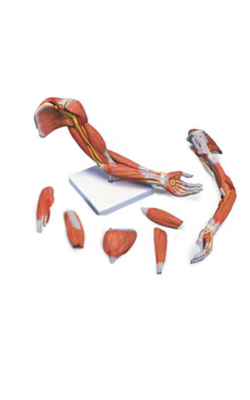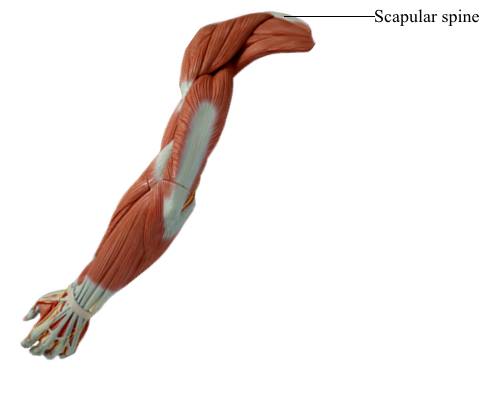Main Model

13 Scapular spine

Scapula
The scapula (shoulder blade) is a triangular flat bone that lies on the posterolateral aspect of the thorax, overlying the 2nd-7th ribs. The convex posterior surface of the scapula is unevenly divided by a thick projecting ridge of bone, the spine of the scapula, into a small supraspinous fossa and a much larger infraspinous fossa. The concave costal surface of most of the scapula forms a large subscapular fossa. The broad bony surfaces of the three fossae provide attachments for fleshy muscles. The triangular body of the scapula is thin and translucent superior and inferior to the spine of the scapula; although its borders, especially the lateral one, are somewhat thicker. The spine continues laterally as the flat, expanded acromion (Greek akros, point), which forms the subcutaneous point of the shoulder and articulates with the acromial end of the clavicle. The deltoid tubercle of the scapular spine is the prominence indicating the medial point of attachment of the deltoid. The spine and acromion serve as levers for the attached muscles, particularly the trapezius.
Because the acromion is a lateral extension of the scapula, the acromioclavicular joint is placed lateral to the mass of the scapula and its attached muscles. The glenohumeral (shoulder) joint on which these muscles operate is almost directly inferior to the acromioclavicular joint; thus the scapular mass is balanced with that of the free limb, and the suspending structure (coracoclavicular ligament) lies between the two masses.
Superolaterally, the lateral surface of the scapula has a glenoid cavity (Greek socket), which receives and articulates with the head of the humerus at the glenohumeral joint. The glenoid cavity is a shallow, concave, oval fossa (Latin fossa ovalis), directed anterolaterally and slightly superiorly - that is considerably smaller than the ball (head of the humerus) for which it serves as a socket. The beaklike coracoid process (Greek korak-odés, like a crow's beak) is superior to the glenoid cavity, and projects anterolaterally. This process also resembles in size, shape, and direction a bent finger pointing to the shoulder, the knuckle of which provides the inferior attachment for the passively supporting coracoclavicular ligament.
The scapula has medial, lateral, and superior borders and superior, lateral, and inferior angles. When the scapular body is in the anatomical position, the thin medial border of the scapula runs parallel to and approximately 5 cm lateral to the spinous processes of the thoracic vertebrae; hence it is often called the vertebral border. From the inferior angle, the lateral border of the scapula runs superolaterally toward the apex of the axilla; hence it is often called the axillary border. The lateral border is made up of a thick bar of bone that prevents buckling of this stress-bearing region of the scapula.
The lateral border terminates in the truncated lateral angle of the scapula, the thickest part of the bone that bears the broadened head of the scapula. The glenoid cavity is the primary feature of the head. The shallow constriction between the head and body defines the neck of the scapula. The superior border of the scapula is marked near the junction of its medial two thirds and lateral third by the suprascapular notch, which is located where the superior border joins the base of the coracoid process. The superior border is the thinnest and shortest of the three borders.
The scapula is capable of considerable movement on the thoracic wall at the physiological scapulothoracic joint, providing the base from which the upper limb operates.